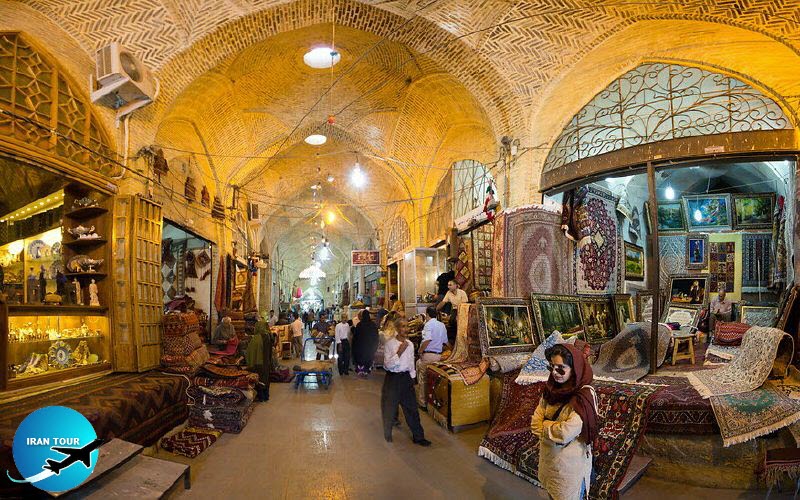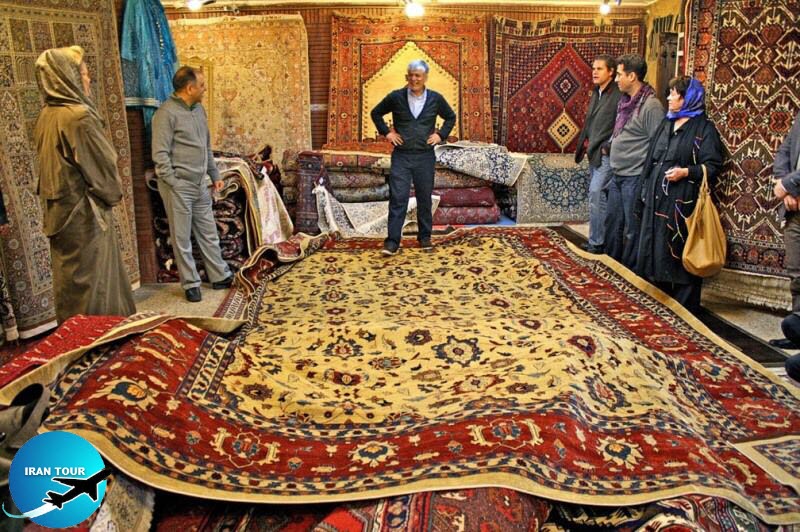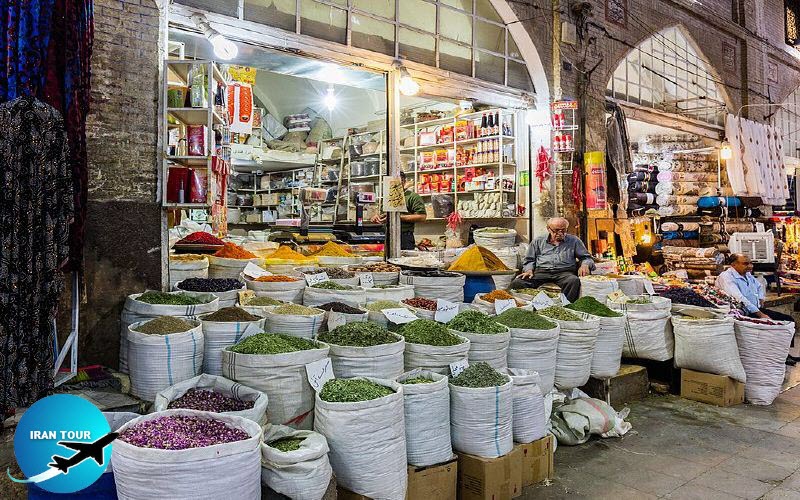Copyright 2020 - 2021 irantour.tours all right reserved
Designed by Behsazanhost
Vakil Bazaar
Vakil Bazaar
Virtually no Iranian town exists without its bazaar, in which craftsmen, retailers, and wholesalers, grouped according to their business, work, sell, or buy. Although the tendency today is for enterprising shopkeepers and merchants to move out of the bazaars into the more modern commercial districts, bazaars still play an important role in Iranian life - not only as of the main centers of commerce, but also as influential elements in the social, cultural, and political life of the cities.
 |
Although the marketplace undoubtedly existed in Shiraz since remote antiquity, our earliest evidence of it dates from the Buyid period. Under subsequent rulers, the bazaar was essentially expanded and rebuilt. Four bazaars were added to the complex during the Salghurid period, and they linked the Mausoleum of Shah Cheragh to the Old Congregational Mosque. These bazaars were known as Sar-e Chahar Rah and were demolished during the expansion of the court of Shah Cheragh. Another bazaar, called Sar-e Howz-e Aqa, also existed beside the Mausoleum of Shah Cheragh and was contemporary with it, but it was also ruined. Davud Khan's Bazaar dated from the Safavid period; it started from the Royal Square, located perhaps where later the complex of the Regent's structures was built. This bazaar was substituted under the Zands by the Mesgarha ("Coppersmiths”) bazaar.
 |
The most ancient extant core of the Shiraz Bazaar is known as the Hajji Bazaar. This name may derive from Hajji Qavam al-Din Hasan, the vizier of Shah Sheikh Abu Eshaq. The bazaar starts from the northwest of the Congregational Mosque and stretches northward. The most famous of the Shiraz bazaars is the Vakil (Regent's) Bazaar. Built in 1766 in the best traditions of Iranian urban architecture, It is one of the Zand masterpieces. This bazaar was constructed on a cruciform plan, following the layout of the Qeysariyeh Bazaar in Lar. It consists of a long vaulted avenue, built of yellow-fired bricks. It is crossed by a shorter transept, with a neat square surmounted by a dome (Chahar-Sou), marking the point of intersection. The north and south vaulted passages housed eighty-two shops each. The west wing kept twenty shops, while the east wing included thirty-eight shops. From the main bazaar lanes, gateways led into extensive caravanserais, where camels and horses were stabled and goods were stacked. Besides these caravanserais, a mint was located during the Zand period. At that time, the bazaar was owned by the royal house, and the shops were rented to the shopkeepers for a small fee.
 |
The Regent's bazaar survives today as a thriving commercial center though in a much-changed condition due to later alterations in town planning. Today, it accommodates about one hundred and eighty carpets and rugs, spices, fabrics, and handicrafts. The handsome Nou Bazaar starts at the northernmost point of the Vakil Bazaar and stretches to the Esfahan Gate. It was created during the Qajar period and is very similar in plan to the Zand structure. It was founded by Mirza Yusef Ashrafi Mazanderani, the local governor, and was called after him until the end of the Qajar rule. The shops of the Nou Bazaar specialize in textiles, leather goods, and objects of the household. Beside the south entrance to the Vakil Bazaar diverges a roofed shop lane that links it to the Moshir Bazaar and Caravanserai.
 |
What to buy as Souvenirs
Shiraz is a great place to buy souvenirs, the quality of which is usually high and the price is quite reasonable. The best items to shop for here are carpets, jewelry, silver and bronze smithing, textiles, embroidery, khatam items, and spices. One of the indigenous crafts in Shiraz has long been tile-making, especially in the style known as polychrome in which various colors are applied to the surface of regular square tiles before they are cooked. Most of the tiles ordered for the shrines had a religious theme, and
those destined for mansions or palaces were often embellished with floral compositions and scenes of merry-making. In other towns of Fars, handicrafts are also rich in diversity, and the most significant of them are marquetry and Giveh (light cotton summer shoes) in Abadeh; ceramics in Estahban; Gabeh and kilim in Firuzabad and other Qashqai centers. Other industries like cloth weaving and glass blowing are scattered throughout the province. Rosewater made in Firuzabad, sweets produced in Fasa, and lime juice and plant essences extracted in Shiraz are of the highest quality.
 |
Buying carpets
While purchasing carpets, avoid going into a shop with a group to buy them, but it is wise to take an Iranian friend to help you choose a good item. Unless you are an expert, never buy a carpet as an investment - buy it because you like it, and even then only if you have some idea what sort of price you would pay for a similar piece back home. Buying a rug, spread it on the floor to make sure that it lies straight. Check that the pattern is balanced, the borders are of the same dimensions, and the ends are roughly the same width. The colors should be clear and not bleeding into one another. The more distinct the pattern on the underside of the carpet, the better the quality. You may wet a handkerchief and rub it hard on the carpet, rejecting it if there is the faintest color on the linen. You may also try to count how many stitches go to the square inch - the larger the number, the finer the carpet. There are three main kinds of rugs on sale: fine carpets, kilims, and Gabehs. It is currently not permitted for foreigners to post carpets out of the country (however, it may be possible for the dealer you buy your carpet from to do so on your behalf - you need to do research here).
 |
Buying jewelry
Gold (18 carats unless specified otherwise) and silver pieces are sold by weight, with a modest sum added for workmanship. The daily price of gold is usually displayed in the shop windows. Turquoise is a good investment, but it is really hard to sort out the original stones among the fakes.
 |
| Spices are a popular souvenir, especially a mixture of seven spices, locally called haft Adviyeh-perfect for stews, fish and chicken. |
Today this is the main center for selling local souvenirs and handicrafts. The Moshir caravanserai", also known as Golshan, was built by Mirza Abulhasan Moshir al-Molk. It has a typical layout and consists of shops organized around a courtyard with a large pool in the middle surrounded by flowerbeds. The octagonal hall, topped by a dome, on the north side is the most important part of the complex.
Located near the Regent's Bazaar is the Ahmadi Caravanserai, consisting of the andaruni and birunit areas, with a great number of travelers' chambers built on two floors. Their wooden doors exhibit fine examples of marquetry. Each side is marked by the Eivan accented by monolithic stone pillars and panels of polychrome faience. The courtyard has a round pool and an old stone trough. Located behind the Ahmadi Caravanserai is the Gomrok Caravanserai, which in the past used to house the customs office of the bazaar.
Rowqani Caravanserai is found along the main street of the Vakil Bazaar and is connected to it by a corridor. Another important caravanserai is Fil Caravanserai, located in the western part of the Regent's bazaar. It is a quadrangular structure, each side of which has seven chambers, with an additional chamber in every corner. Fortunately, most decorations, including the handsome tilework and fretted doors of these chambers, have survived.
- Details
- Category: Museums of Shiraz









